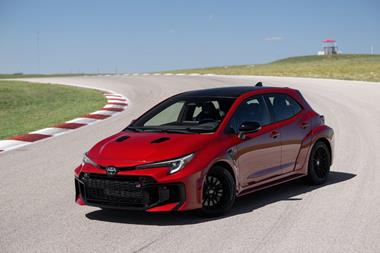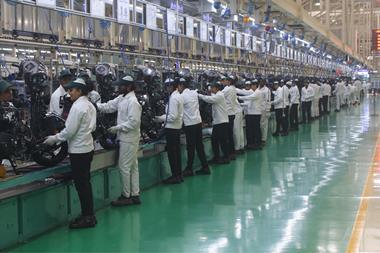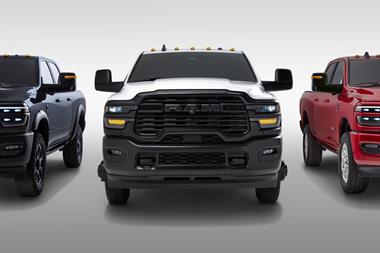Brazil especially is attracting big investments from global vehicle-makers despite economic uncertainties
For almost 15 years, Brazil and Argentina have operated a trade agreement which manages automotive imports and exports between the two countries. While a new deal is being negotiated, a modified version of the existing arrangement has been extended through to 2015. At its heart, this deal allows Brazil to export $1.5m worth of cars to Argentina for every $1m which flows the other way. In sales terms, the two markets are quite different: Argentina totalled just over 950,000 units in 2013, in comparison with Brazil’s 3.76m. Both have slowed down in 2014 and in particular the Brazilian market fell by nearly 12% in the first seven months of the year.
From a manufacturing perspective, the two countries are dependent on each other, although in terms of export ratios, Argentina is more dependent on Brazil than vice versa. In the first five months of 2014, Argentina produced just under 260,000 vehicles, of which nearly 140,000 were exported, mostly to Brazil. Over the same period, Brazil produced 1.35m vehicles, the majority for its home market, but most of the 140,000 exports went to Argentina.
For Brazil and its increasing production capacity, there is some concern over how much export market potential actually exists for vehicle manufacturers, partly because of trade agreements with other countries and partly because of the strategies employed by the OEMs themselves, which increasingly want to localise production. The ‘produce-where-you-sell’ approach has recently led to a renewed burst of investment in Brazil, despite the economic uncertainty in the country and the risk of over-capacity arising from this investment. All the signs point towards Brazil continuing to drive the automotive fortunes of Latin America.
In reflection of the trade flow agreement referred to above, most of the OEMs with established operations in Brazil and Argentina have factories in not one but both countries. Certainly, this is the case with Fiat, Ford, General Motors, Honda, Iveco, Mercedes (trucks rather than cars), PSA, Renault, Toyota and Volkswagen.

Moreover, the vehicle companies are now producing – or planning to produce – the same generation of vehicles in Brazil as they make elsewhere in the world. Global platforms and the drive for increased economies of scale mean that the days of VW making an older version of the Golf or Polo in Brazil compared with Europe – or even China – is over. With the right trade agreements in place, these developments should also open up export potential across the globe, from Brazil especially – something which has hitherto been notable by its absence.
Short-term shakiness
The main driver behind production growth in Brazil in recent years has been domestic demand rather than exports. At least that was the case until last year, when domestic demand for cars fell by 1.3% from 2.85m to 2.76m units, representing the end of nine years of consecutive market growth. The decline in car registrations in 2013 reflects a combination of a tougher credit environment, rising interest rates and inflation, and lower-than-expected GDP growth; the fall in 2013 volumes was lower than might have been expected because some sales were brought forward ahead of a rise in purchase tax in 2014.
The short-term economic outlook for Brazil and the surrounding countries has recently worsened. Growth in 2014 is expected to be 1.8%, compared with 2.3% in 2013, although 2015 should see a recovery to 2.7% annual growth. By contrast, Argentina grew by 4.3% in 2013 but is expected to see just 0.5% growth in 2014, and 1% in 2015. Regardless of the prevailing uncertainty, the importance of the automotive industry to Brazil’s economy is marked and growing; according to a recent Reuters report, automotive represents around one-fifth of the national manufacturing output.
The recent worrying economic performance was reflected directly in new light vehicle sales, which fell by over 7.5% in the first seven months of 2014. This trend is expected to continue throughout the year, not only because of economic doubts but disruption to normal market operations caused by the World Cup which Brazil hosted this summer.

In the short term, vehicle production is expected to fall by around 10% for the whole of 2014 alongside a decline in sales of over 5%. The figures for July were especially poor, with monthly output down by almost a quarter compared with June 2013.
Despite these worries, the long-term prospects for the industry look good. Unlike developed European markets, there is significant potential for further growth in Brazilian vehicle sales; whereas Germany, France and the UK have approximately 600 vehicles per 1,000 people, for Brazil there are just 200 per 1,000. And although the Brazilian light vehicle parc has more than doubled since 2000, there remains significant potential there for further growth.
Long-term prospects
Belief in the long-term potential is being manifested by new plants and expansions which are expected to come on stream in the next few years. Further details on these investments are provided below, but in short around 20 schemes are currently underway and should generate further annual production capacity of 2m units to add to the existing manufacturing footprint in the country; in 2013, Brazilian car and van plants produced 3.74m vehicles. By 2017-18, capacity in Brazil is on track to reach 6m units, putting it on a par with Germany.
The big question for the industry is whether this is too much, too soon: will local demand really be able to absorb this capacity, or will Brazil manage to secure significant export markets? The problem is that, globally, there is too much vehicle production capacity already, and fears of an excess are regularly voiced. In light of this, it is pertinent to look closely at why so many vehicle-makers are expanding in Brazil: the principal reasons are the size of the local market, its potential for further growth and the high levels of import duty.
One of the most important aspects of the current round of investment in Brazil is that it does not only involve the established global American, European, Japanese and indeed Korean brands. Major Chinese vehicle manufacturers are also set to establish operations in the country by the end of 2016; Chery and JAC are merely first off the mark with a total investment of more than $1 billion in two new plants, one of which opened this September. Moreover, these new contenders in Brazilian automotive manufacturing will use the country as a base from which to serve the rest of Latin America.
BMW
In 2012, BMW became the first of the German premium brands to confirm a substantial investment in Brazil. The OEM is investing €200m ($258m) in a relatively modest plant at Araquari, Santa Catarina, which will initially make 30,000 units per year of the Mini Countryman, 1-Series (five-door), 3-Series sedan, X1 and X3.
Chery
Established at a cost of $400m, the OEM’s new plant at Jacareí, São Paulo, is not only its first full production site overseas but the first in Brazil to belong to a Chinese manufacturer. Capacity will reach 50,000 units in Phase One, focusing on the Celer and QQ, and will rise to 150,000 in Phase Two.
A further $130m has been earmarked by Chery for an Acteco powertrain factory to build 1.0-litre and 1.5-litre flex-fuel power units; another $50m is for a projected R&D centre; and the site will eventually be upgraded to an industrial park involving 3,000 jobs. Chery has said that Jacareí will be producing five different models within 12 months.

For many years, Daimler has operated Mercedes truck plants in both Brazil and Argentina. C-class production, and specifically the C-class coupe (exported to Europe), took place in Brazil from 1999-2010, but in low volumes, and in 2011 the plant at Juiz de Fora, Minas Gerais, switched to truck production.
However, in 2013 a significant investment was confirmed, signalling that Brazil will become an integral part of Mercedes’ global car production footprint. More specifically, €170m is being invested to make the next-generation C-class and the GLA SUV at Iracemápolis, São Paulo, from 2016, albeit with a starting capacity of just 20,000 units.
What is significant – especially in terms of the C-class – is that its production launch follows within a year or so of the production launch in Europe, North America and South Africa.
Fiat Chrysler
In spite of laying off workers at existing operations, the market leader is pressing ahead with its all-new factory in Goiana, Pernambuco, which will have a capacity of 250,000 units per year. This will open at the end of 2014, with full series production starting early in 2015. The new factory, costing around €1.3 billion, will start by building the Jeep Renegade and Fiat 500X, becoming the second factory to make these vehicles after the start of production at Fiat Melfi in Italy by the end of 2014. In addition, the factory is expected to build a larger C-segment SUV for Jeep, the new Fiat Linea B-segment and Viaggio C-segment cars.
There will be substantial investment by suppliers. Fiat has announced that 16 companies will operate 17 new factories to supply the vehicle plant, accounting for around 40% of the vehicle content and generating 4,000 new jobs. A further 40% of the vehicles’ value will come from other locations in Brazil, producing a total local content of 80%. The suppliers include: Adler (carpets and headliners); Brose (window winders); Denso (HVAC); Faurecia (plastic trim); Lear (seats); Magneti Marelli (fuel tanks, brakes, clutches, exhausts and stampings; Pirelli (tyres); and Saint-Gobain (glass).
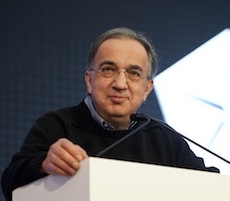
Ford
The fourth-largest vehicle-maker in Brazil has signalled its commitment to the market in both conventional and unconventional ways. Starting with the more unusual approach, back in 2007 Ford’s Brazilian operations acquired the local SUV manufacturer Troller, which specialises in traditional, rugged 4x4s. Seven years later, the first new Troller model has appeared under Ford ownership; this is akin to how a larger Jeep Wrangler combined with a Land Rover Defender might look.
In the more conventional route, Ford has used its South American operations, especially those in Brazil, to design and develop the new Ka (which will also be sold in Europe); the Figo name is expected to be used in India, where the vehicle is also due to be made. The new car has been largely designed and developed by Ford Brazil, although Ford of Europe has certainly been involved in the details. This programme has gone a long way towards proving that Ford Brazil has what it takes to become an integral part of the One Ford global strategy. The total investment in the Ka programme is around $2 billion, with more than half of this going towards the expansion and improvement of the Ford factory in Camaçari, Bahia, where the Ka will be made alongside the EcoSport small SUV.
General Motors
Irrespective of the current downturn in the Brazilian market, GM is maintaining its decades-long commitment to the country. In mid-August, the OEM announced an investment of $2.8 billion over the next five years for the development of new products, technologies, training and component localisation, with the bulk of this to be spent at its existing plant at São Jose dos Campos, São Paulo.
Honda
In November 2013, Honda began construction of a plant at Itirapina, São Paulo, with a capacity of 120,000 units per year. The factory is due to become operational by the end of 2015 and by this date will have received a total investment of around ¥43 billion ($401m). The plant will make the new B-segment Fit and its derivatives.
 JAC Motors
JAC Motors
Following a $600m investment, the OEM’s new plant on a greenfield site in Camaçari, Bahia, will become operational in December this year, with a capacity of 100,000 cars and 10,000 trucks.
By the end of next year, JAC will be producing at least four different passenger cars in Brazil based on the J3 platform but tailored for the local market. The supplier park will include six to 12 companies.
Jaguar Land Rover
In the UK, JLR is growing rapidly and may run out of capacity if programmes and production volumes continue at their current growth rate. Whether the OEM builds a plant in its home nation is another matter, but expansion across the globe will certainly take place, with plants opening in China, India and possibly even Saudi Arabia.
JLR will open a new facility at Itatiaia, Rio de Janeiro, in 2016. The investment of £240m ($389m) will result in a small plant with an initial capacity of just 24,000 units per year, similar to the new BMW and Mercedes facilities. The OEM has not confirmed which models will be made in Brazil, although a version of either the Freelander replacement or the Evoque would seem most likely.
Renault-Nissan
Renault has been producing vehicles in Brazil since 1998 and although it is only the fifth-ranked OEM by sales, the country is very important to the brand, as its second-largest market after France. Indeed, Renault Brazil started making the new Master van at more or less the same time in 2013 as the model was launched in Europe. Renault will invest around 500m reais ($214m) over the next five years in Brazil, mainly at its three-plant complex in Curitiba, Paraná. This will support the production launch of two as yet unnamed models.
Alliance partner Nissan is now expanding significantly in Brazil as well, having initially started local production in 2000 with the Frontier pick-up truck at the Renault factory in São Jose, Santa Catarina. Interestingly, this does not just mean manufacturing; a design studio was opened in Rio de Janeiro in August 2014. This development followed the establishment of a new factory at Resende in the same State. With a capacity of 200,000 per year, this factory forms an essential part of Renault-Nissan’s strategy to achieve a 15% share of the Brazilian market – almost a three-fold increase on the current figure.
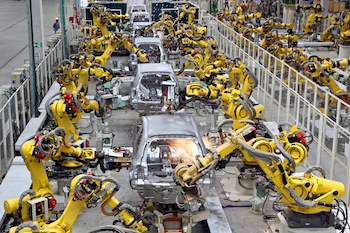
As well as vehicle production, Resende will make the 1.6-litre flex-fuel engine for the March and Versa. Capacity for 200,000 engines per year has been installed and the first units, which are now in production, have a 50% local content level.
Carlos Ghosn, the Brazilian-born CEO of Renault-Nissan, has stated that increasing local content is a key strategic objective for the two brands in Brazil. Longer term, the idea will be to integrate Renault and Nissan production into one operation.
Volkswagen
A veteran of Brazilian production, VW has sought to consolidate its position in the country by adding production capacity for its global MQB platform (allowing the new Golf and various derivatives to be made there) and also by establishing full production facilities for Audi in the country.
In September 2013, after many months of speculation, Audi confirmed that it would make the Q3 SUV and A3 sedan inside the existing VW facility at São Jose dos Pinhais, Paraná. The previous A3 had also been made in Brazil but production stopped back in 2006. The new models will involve an investment of $200m.
Shortly after this announcement, VW confirmed that it would add the new Golf to its portfolio at São Jose dos Pinhais. Here a further €170m is to be invested in manufacturing technology, mainly related to the MQB platform which underpins the A3,Q3 and Golf. By the end of 2016, VW claims it will have invested close to €3.5 billion in the country in less than a decade.































